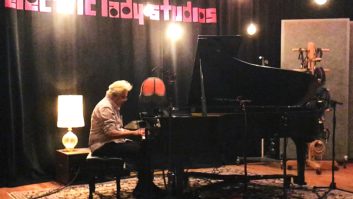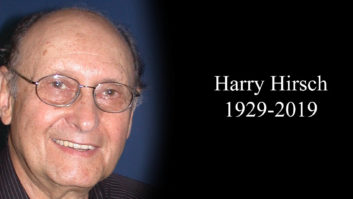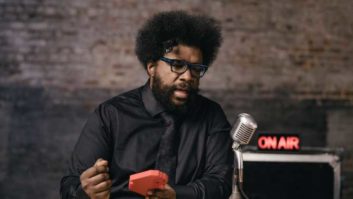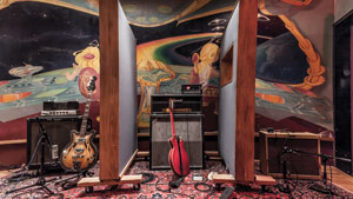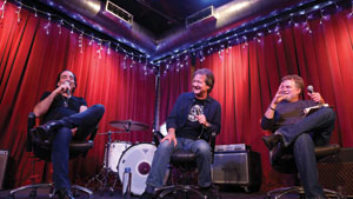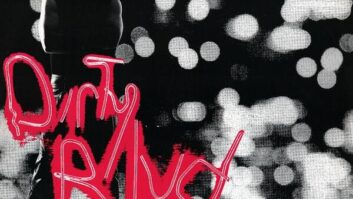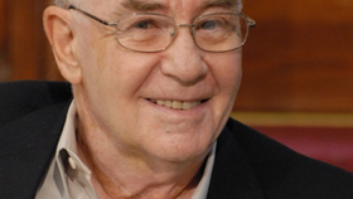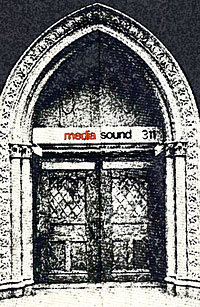
The fabled entrance to the Studio of the ’70s
photo: Courtesy Harry Hirsch
Bob Clearmountain, Godfrey Diamond, Michael Barbiero, Michael Delugg, Harvey Goldberg, Joe Ferla, Jeff Lesser, Alec Head, Bill Stein, Ron Saint Germain, Michael Brauer, Don Wershba, Ed Stasium, Gregg Mann, Carl Beatty, Kol Marshall, Lincoln Clapp, Joe Jorgensen, Alan Varner, Doug Epstein, Liz Saron, Trudy Schroder, Ramona Janquitto, Ron Dante, Charlie Calello, Tony Bongiovi — these are just some of the names that became the nucleus of Mediasound.
In New York City, from the close of the ’60s through the birth and death of disco, Mediasound was a hit machine. Founded by Harry Hirsch, with assistance from Bob Walters and financial/business backing from owners Joel Roseman and the late John Roberts, Mediasound opened in June 1969 at 311 West 57th St. in the heart of Manhattan. Once home to the Manhattan Baptist Church, today the site is occupied by Providence (formerly the trendy Le Bar Bat), where you can still see the Gold Records on the wall.
The live room, home to the hits, with, from left, the late Joe Jorgensen, chief engineer Fred Christie and founder Harry Hirsch
photo: Howard Sherman
The original idea came out of a random talk between Hirsch and Walters, who then went looking for money. “There were many 4-track studios in New York City,” recalls Roseman. “There was room for a state-of-the-art facility, one that could handle any kind of recording, tape copies, mastering — so we decided to change the scope of the idea. We went from the original $100,000 investment to over $1 million. It took a very long time to find the space, but Harry Hirsch found the Baptist church on 57th Street.”
“I will always be grateful to John Roberts, Joel Roseman and Bob Walters,” Hirsch says, “who listened when I told them, ‘I found a church from heaven on 57th Street,’ and trusted me to design, build and be its first president.”
A contemplative Barry Manilow in the live room.
Producer Ron Dante: “I brought in my new recording
artist Barry Manilow to record his second album—the one that included our first breakthrough million-seller ‘Mandy.’ Right away we knew that Mediasound was the place to make the best-sounding records in the business.”
photo: Courtesy Harry Hirsch
Fred Christie, chief engineer and a sort of father figure to, as he calls it, “all my kids,” remembers: “To get the studio in shape, we first had to build up the floor on the main level because it sloped out toward the altar.” Roseman adds, “It was a raked floor so that the people in the back of the church could see, but we had to install a huge floor shim to make everything level. Those huge wooden front doors set the tone for the church, and we retained much of that atmosphere throughout, including all the stained glass, especially in Studio A.”
Before the walls were even up, word got out that the studio was being built, and Roseman and Roberts were approached about doing a second facility, this one upstate. “We were not sure about the upstate recording studio, but went anyway to check it out,” says Roseman. “We were told that if the studio was built, there would be a press party with Bob Dylan mingling with all the record company and A&R executives. I said, ‘Why don’t we skip the studio but do this concert idea that I had with Dylan?’ We would have Bob and others perform, and with the profits of the concert, we would go ahead and build the second studio in upstate New York.” The “concert,” of course, was Woodstock. Dylan didn’t perform, the second studio was never built, but Roseman and Roberts still managed to throw quite a party.
The friendliest general manager in New York, Susan Planer. Owner Joel Roseman: “Susan was such a veteran. She could be in the room with anyone and they would always say that she was the most considerate and fair-minded person.”
photo: Bobby Bank
While the list of engineer/producers that made their way through Mediasound is impressive enough, the flow of artists and musicians was equally noteworthy. Tony Bongiovi did Gloria Gaynor’s “Never Can Say Goodbye” in Studios A and B; Godfrey Diamond engineered Frank Sinatra, with Charlie Calello and Joe Beck arranging and producing on the Paul Anka tune “Everybody Ought to Be in Love”; Ron Dante brought in Barry Manilow for “Mandy” and Pat Benatar for her second record, the hit Crimes of Passion; Michael Brauer got his break with Luther Vandross. Add in Frankie Valli, Nancy Sinatra, Englebert Humperdinck, the Rolling Stones, Ben E. King, Stevie Wonder. Then there were the session players such as Will Lee, Paul Shaffer, Richard Tee, Andy Newmark, Steve Gadd, Rick Marotta and Bob Babbitt of the Funk Brothers.
“Mediasound was a studio that had everything going for it,” Babbitt says. “I was able to get great bass sounds, especially from Studio A. It had a sound that no other studio had, complete with stained glass that was kept intact.” Studio A became the talk of New York; it was architecturally flamboyant and the scene of many hit sessions. Hank Meyer, booking manager, remembers Mick Jagger wearing a mink coat and sporting a beard, just coming off 57th Street wanting to take a look at Studio A.
From left, Charlie Callelo, Bob Clearmountain and Michael Barbiero in Studio A.
Inset: Callelo conducting in the former church’s live room
photo: Bobby Bank
Of course, the producing and engineering talent went on to other studios and long careers — perhaps most notably, Bongiovi and Walters heading a few blocks away to open the premier 1980s recording studio, Power Station, now known as Avatar.
Still, you can’t forget the magic. As Bongiovi recalls, “Mediasound’s room was good for musicians. We developed and implemented a few ideas that came from Motown, such as talkback directly into the headphones, switch tracks on and off, switch the echo send on and off or the effects send on and off. We put the four switches in, which was great. But mostly, it was a big church with a very live room — a sound that no one else had.”
Elliot Mazer will conduct a presentation of historic New York recording studios on Sunday, October 9, at 1:30 p.m. at the AES Convention. — Eds.
photos: Bobby Bank
Bob Clearmountain (Kool & The Gang, Sister Sledge, Gloria Gaynor and countless others) was handpicked to change the light bulbs 40 feet up in the cathedral ceiling. “I was the only one nuts enough to go up there!” he recalls.
Producer Ron Dante with Pat Benatar. Dante: “Being in Mediasound always made you feel like you were about to create a hit.”
Tony Bongiovi, front, seen here with
Trini Lopez in 1978, at Power Station
The owners, at Woodstock ’94, 25 years after the original: Joel
Roseman (L) and the late John Roberts
Pat Benatar
Charlie Callelo

